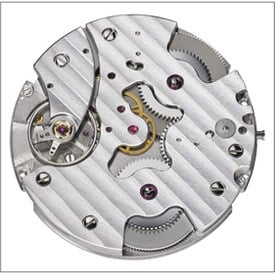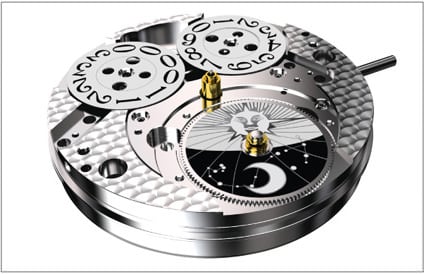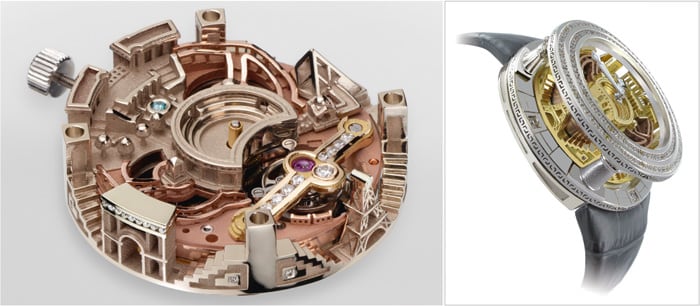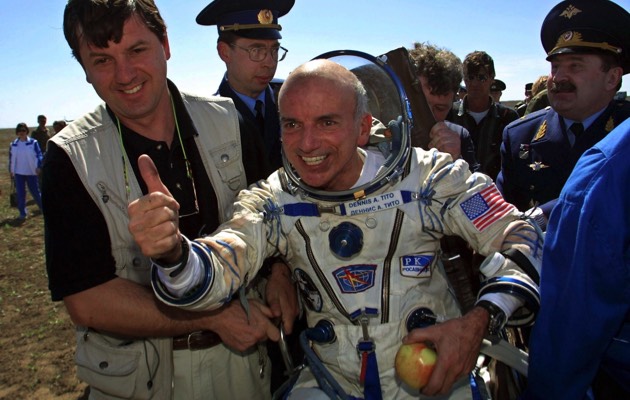“Technotime is still a small player but a very determined one. We are getting stronger and are increasing our volume. Step by step, we are building our credibility,” affirms the trio of Laurent Alaimo, the brand’s CEO, François Dreyer, director and member of the board of directors, and Sébastien Gigon, sales director.
The spotlight recently turned towards
Technotime, when, to everyone’s surprise, the brand won third place in the 2011 International Chronometry Competition in the Tourbillon category, behind the two heavyweights,
Greubel Forsey and
Chopard Manufacture. This award could not have come at a better time for the team that had developed its own calibre, the TT791.50, which features a 60-second tourbillon and double barrel, and was developed with more limited means than its competitors. Plus, with an added element of pride, this calibre was equipped with a balance spring that was produced entirely “in-house”.
Technotime has thus now entered the very restricted club of balance spring makers. To better understand where the brand is now, let’s take a step back in time.
From the ashes of France Ebauches
Technotime came out of the woods during BaselWorld in 2004. The era seemed propitious. Consolidations and verticalisations were the norm. China was getting stronger. The
Swatch Group began tightening the screws. New opportunities thus started to appear for suppliers and other movement makers. “Yet, to actually pass to the execution stage was another thing,” explain the three men. Armed with a great deal of enthusiasm,
Technotime entered the battle that year with a globally integrated model: to design, fabricate component parts and balance springs, and finally to assemble them.
Yet, the global economic crisis would put the brakes on the company’s integrated model.
Technotime was, in fact, born from the ashes of France Ebauches. But the French company, which had mastered all the watch metiers, except surface treatment and decoration, including fabrication of the balance spring, was growing old. “The French structural rigidities, the lack of flexibility, the inability to adapt, and the prohibitive costs would not allow us to fully re-launch France Ebauches,” add the trio. The primary stakeholder, the Chinese Chung Nam group, agreed that
Technotime should change its tactics, which meant giving up its total integration model while falling back on its core metier: on one hand, the realisation of proprietary calibres and, on the other hand, the in-house production of balance springs. As for the remainder—production of component parts, decoration, finishing, and assembly—that would be carried out in close collaboration with a firmly established network of partners.
 - TT718
|
 - TT651
|
Double barrel calibre
In terms of movements, the spearhead of
Technotime is a very interesting calibre 13¼’’’ (or 30 mm in diameter), which answers to the name of Movement TT 718 in its manual-winding form and TT 738 in its automatic version. Beating at 28,800 vibrations per hour (4Hz), its double barrel provides for the long power reserve of 120 hours or five days. It was designed to be a veritable tractor that would permit the development of small simple complications—integrated or modular—such as, for example, a patented big date with a second time zone for hours and minutes, as well as a large disc indicator for day and night. In its basic version, this calibre also includes either an instantaneous date in a window or a retrograde date at 1:30. It also offers the possibility of leaving the balance visible. All of these movements are certified by the COSC.
The second family of
Technotime movements —while awaiting a big date chronograph movement, currently in the functional prototype stage of development—is the TT 791. This family of 4-Hz tourbillon movements includes the TT 791.50 that won third place in the Concours de Chronométrie. With the tourbillon placed at 9 o’clock, these models are available in many versions, and can add a power reserve indicator, a retrograde date, and a small seconds indicator on the axis of the tourbillon, depending on the design specifications and the display of
Technotime’s brand partners.
The interest of the double barrel, which supplies energy to the tourbillon, resides not only in offering a power reserve of 120 hours—with an optimal range of 80 hours—but also in creating superior regulation and thus excellent chronometry. In addition, its ability to adapt to specific client requests, to offer various types of execution—classic or more modern as well as skeletonising—confers upon the movement an amazing versatility. Spectacular proof is the remarkable and very sculptural tourbillon developed for French brand
Tournaire (see the illustration above).
 - TOURBILLON TECHNOTIME developed for TOURNAIRE
|
Today,
Technotime’s tourbillon atelier produces between 70 and 100 tourbillons per year. As for the other models mentioned above, we must say that they are also adaptable on bases of
ETA 2892 and
Sellita SW 300. More than 150,000 of these modules with a large date have already been delivered by
Technotime.
Mastering the balance spring
The production of balance springs is Techno-time’s second largest activity. With total mastery of the technology and its processes, from A to Z, the company has declared a production capacity of “nude balance springs” ranging from 30,000 to 40,000 per month. By “nude balance spring”, it means all the industrialised operations before the spring is pinned to the collet, in other words, drawing, rolling, cutting, winding, pressing, fixing, and separation of the flattened balance springs.
Technotime follows two different “recipes” for its alloys: Nispan C, a material developed by the Japanese that is nearly identical to Elinvar, but with a greater sensitivity to thermal coefficients; and a second alloy developed in conjunction with a French university, which is lighter and less sensitive, and seems to have potentially superior chronometric performances.
Categorised into twenty different classes, this nude balance spring is then cut at the centre, followed by preassembling and laser-soldering in an argon gas atmosphere to the collet (realised using the Liga process), before the final external cutting. The balance spring is then reclassified before being assembled to its balance that belongs to the same class. The final steps involve balancing, centring, and quality control.
All of these operations involve many manual interventions and while the price of the nude balance spring varies between CHF 3 and CHF 5, a complete assortment is priced between CHF 35 and CHF 80. “Clearly, when compared to
Nivarox – FAR,” explains Michael Boulnois, the young manager of the balance spring workshop, “our offer is still small, with 30,000 to 40,000 complete assortments produced per year. But, we have, on the other hand, the advantage of being flexible and the ability to adapt the balance spring exactly to our client’s product, and not the other way around.” This is, without a doubt, one of the keys to the future success of the assortments proposed by
Technotime—and also one of the reasons that make this alternative supply so vital for the development of independent brands.




















